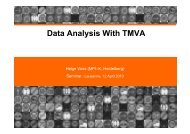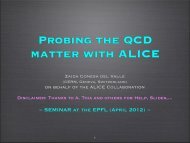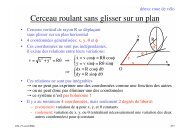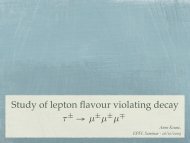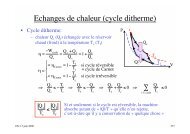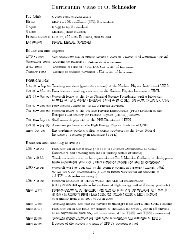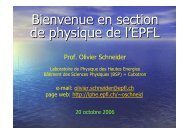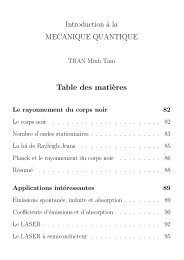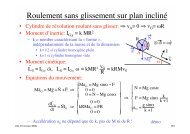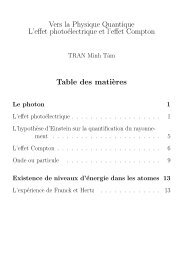Slide
Slide
Slide
You also want an ePaper? Increase the reach of your titles
YUMPU automatically turns print PDFs into web optimized ePapers that Google loves.
Thermal History of<br />
Subject chosen from CHIPP Winter School<br />
the Universe<br />
Anne Keune<br />
04-04-2011
02/15<br />
Overview<br />
• In this presentation I will shortly discuss the following topics<br />
(which follow the expansion of the universe):<br />
• neutrino decoupling<br />
• e+/e- annihilation<br />
• big bang nucleosynthesis<br />
• recombination<br />
• photon decoupling
03/15<br />
Neutrino decoupling<br />
• The early universe was dominated by relativistic particles (e + /e - /νe/γ),<br />
hot and dense and not opaque to even weakly interacting neutrinos.<br />
all particles in thermodynamic equilibrium<br />
Weak interactions:<br />
n + νe ↔ p + e - , n + νe + e + ↔ p, e + + e - ↔ νe + νē<br />
• But as the universe expanded and cooled down, the distance between<br />
particles increased and the expansion rate of the universe (H)<br />
overtook the neutrino interaction rate (Γ)<br />
• At this point the neutrino’s departed from equilibrium and decoupled<br />
Γ >> H: neutrino’s in equilibrium<br />
Γ
• The weak interaction rate is given by<br />
nν = (3gζ(3)T 3 )/(4π 2 )<br />
back-up 1<br />
04/15<br />
Neutrino decoupling<br />
• The expansion rate of the universe<br />
• Ratio:<br />
Γ(T) = n ⋅ 〈σν〉 ≅ 2.54 ⋅ GF 2 ⋅ T 5<br />
≅ 3.48 ⋅ 10 -22 ⋅ (T/MeV) 5 .<br />
H(T) = (8πG/3 ⋅ ρ) 1/2 (Friedmann eq.)<br />
≅ 4.46 ⋅ 10 -22 ⋅ (T / MeV) 2 .<br />
Γ(T)/H(T) ≅ 0.78 ⋅ (T/MeV) 3 .<br />
• Neutrino decoupling thus occurred at<br />
T ≅ 1.09 MeV, only ∼7 seconds after the<br />
creation of the universe.<br />
Fermi coupling constant<br />
GF = 1.17⋅10 -11 MeV -2 .<br />
Newton constant<br />
G = 6.707 ⋅ 10 -45 MeV -2 .<br />
Total energy density<br />
ρ = T 4 /30 ⋅ π 2 ⋅ g*.<br />
Energy degrees of freedom<br />
g* = 2 + ⅞(3 ⋅ 2 + 2 ⋅ 2)<br />
g* = ∑B gB ⋅ (T/Tγ) 4<br />
+ ⅞ ⋅ ∑F gF ⋅ (T/Tγ) 4<br />
gγ = 2 : photon spin states<br />
ge = 2 ⋅ 2 : e + /e - spin states<br />
gν = 3 ⋅ 2 : six neutrino’s<br />
T = Tγ = Tν : coupled species
Nowadays...<br />
05/15<br />
e + /e - annihilation<br />
• Energy dropped below me = 0.5 MeV after decoupling . The energy<br />
released by the annihilation of electrons and positrons heated the<br />
photons, but not the decoupled neutrinos.<br />
• For Tνdec > T > me : g*S = 2 + 7/8(2 ⋅ 2) = 11/2 (neutrino’s decoupled)<br />
For me > T : g*S = 2 (electrons annihilated)<br />
So (Tν/Tγ) 3 = g*Sbefore/g*Safter = 11/4<br />
DMR 53 GHz Maps<br />
Tγ = 2.728 K<br />
The temperature of background photons is higher than of<br />
background neutrinos.<br />
Tν expected to be ∼1.95 K<br />
Tγ ≅ 1.4 Tν<br />
Entropy density: s(T) ∝ g*S ⋅ T 3<br />
g*S = ∑B gB ⋅ (T/Tγ) 3 + 7/8 ⋅ ∑F gF ⋅ (T/Tγ) 3<br />
Adiabatic expansion: d(sa 3 ) = 0 ⇒ (aT) 3 g*S = const.
06/15<br />
Cosmic neutrino<br />
background (CNB)<br />
• But... current neutrino detectors cannot detect neutrinos with an<br />
energy as low as the neutrino background.<br />
Measuring the CNB temperature can be done through measuring<br />
the ratio between Hydrogen and Helium.<br />
• The proton/neutron ratio is dependent of T.<br />
• For this we need to look at the nucleosynthesis process...<br />
4 He<br />
H ?
07/15<br />
back-up 1<br />
Nucleosynthesis<br />
• Before neutrino decoupling all particles were in thermodynamic<br />
equilibrium, including the non-relativistic baryons.<br />
The baryon number density is:<br />
n ≅ g ⋅ (mT/(2π)) 3/2 ⋅ exp(-m/T)<br />
• At ∼0.7 MeV the ratio “freezes in” at<br />
The proton/neutron ratio gives:<br />
nn/np ≅ exp(-(mn-mp)/T)<br />
nn/np ≅ 1/6<br />
• The only reaction that hereafter changes the number of neutrons is<br />
neutron decay, reduces the ratio to<br />
nn/np ≅ 1/7<br />
• Without further reactions to preserve neutrons in stable nuclei, the<br />
universe would be pure hydrogen.<br />
mp ≅ 938.3 MeV, mn ≅ 939.6 MeV<br />
mn-mp ≅ 1.3 MeV
08/15<br />
Nucleosynthesis<br />
• The reaction that preserves neutrons is deuterium ( 2 H) formation.<br />
The number density can be written in terms of B:<br />
ni ≅ gi ⋅ A 3/2 ⋅ exp(Bi/T) ⋅ 2 -A ⋅ np Z ⋅ nn (A-Z) ⋅ (mnT/(2π)) 3/2⋅(1-A)<br />
• The mass fraction of a nucleus is Xi = Aini/nB = Aini/∑ Aini (∑Xi = 1)<br />
with nB the total Baryon density.<br />
Xi ≅ Ci ⋅ η (A-1) ⋅ exp(Bi/T) ⋅ Xp Z ⋅ Xn (A-Z) ⋅ (T/mn) 3/2⋅(A-1)<br />
(present) ratio<br />
Baryon/photon η = nB/nγ<br />
= nB⋅π 2 ⋅(2ζ(3)T 3 ) -1 .<br />
nB = nn + np.<br />
Binding energy (B): Zmp + (Z-A)mn - m<br />
back-up 2<br />
back-up 3<br />
2 H<br />
p + n → D + γ
09/15<br />
Nucleosynthesis<br />
• Xi shows that equilibrium abundances come later (lower T) for nuclei<br />
with small binding energies.<br />
• He nuclei which has a larger binding energy and whose abundance<br />
would become large earlier, cannot be formed.<br />
Deuterium bottleneck<br />
B (MeV) T (MeV)<br />
2 H 2.22 0.07<br />
3 H 6.92 0.10<br />
3 He 7.72 0.11<br />
4 He 28.3 0.28
10/15<br />
Nucleosynthesis<br />
• Once D nuclei are created, the one way process of the creation of<br />
helium nuclei can begin.<br />
• To good approximation all neutrons are now `captured’ in 4 He nuclei,<br />
with a fraction of:<br />
•<br />
Fraction of 4 He nuclei: r = # 4 He/(#H + # 4 He)<br />
r = ½⋅nn/(np - nn + ½⋅nn) = (nn/np)/(2 - nn/np) = (1/7)/(2-1/7) = 7.7%<br />
Mass fraction of:<br />
m4He/mB<br />
= 2nnmp/(npmp + nnmp)<br />
= 2nn/(np + nn)<br />
= 2(nn/np)/(1+ (nn/np))<br />
= 2(1/7)/(1+1/7)<br />
= 25%<br />
2 H 3 H/ 3 He 4 He<br />
D + n → 3 H + γ ⇒ 3 H + p → 4 He + γ<br />
D + p → 3 He + γ ⇒ 3 He + n → 4 He + γ
11/15<br />
Helium/Hydrogen<br />
• Measurements show the Helium/<br />
Hydrogen ratio is in the region of<br />
25%.<br />
• This number is consistent with<br />
our `back of the envelope’<br />
calculation.<br />
• In this calculation Tν ∼ 0.7 MeV<br />
was used.<br />
smaller boxes: ±2σ statistical error<br />
larger boxes: ±2σ statistical and<br />
systematic error
12/15<br />
Recombination<br />
• Radiation and matter in thermal equilibrium as long as there were lots<br />
of free electrons.<br />
• The density of free electrons reduces as T is low enough for electrons<br />
and protons form neutral hydrogen.<br />
before<br />
after<br />
nH in terms of binding energy (B = mp+me-mH = 13.6 eV):<br />
nH ≅ gH/(gpge) ⋅ np ⋅ ne⋅ exp(B/T) ⋅ (meT/(2π)) -3/2<br />
p + e → H + γ
13/15<br />
Photon decoupling<br />
• As the number of free electrons drops, photons decouple at Γ ∼ H<br />
• We introduce fractional ionisation Xe=ne/nB:<br />
assume:<br />
nH = nB-np (only protons)<br />
ne = np (neutral)<br />
(1-Xe)/Xe = nHnB/(nenp) = 4√2ζ(3)/√π ⋅ η ⋅ (T/me) 3/2 ⋅ exp(B/T)<br />
• When we assume recombination at Xe ∼ 0.1 and η ∼ 10 -10 ,<br />
then Trec ∼ 0.31 eV<br />
• Go back to Γγ and compare to matter dominated expansion<br />
then Tdec ∼ 0.26 eV<br />
Origin of CMB!
14/15<br />
Summary<br />
Energy (γ) Time Event<br />
1 MeV 7 sec neutrino decoupling<br />
0.5 MeV 10 sec e + /e - annihilation<br />
70 keV 3 min nucleosynthesis<br />
0.31 eV 300,000 yr recombination<br />
0.26 eV 380,000 yr photon decoupling<br />
0.2 meV 14 Gyr today
15/15<br />
The End
ack-up 1<br />
back-up: number density<br />
• Bose-Einstein/Fermi-Dirac distribution function:<br />
• fFB(k)d 3 k = g/(2π) 3 ⋅ [exp(E/T) ± 1] -1 d 3 k<br />
• Number density: n = ∫ fFB(k) d 3 k<br />
• T >> m (E ∼ k):<br />
• nB ≅ gζ(3)/π 2 ⋅ T 3 ,<br />
• nF ≅ 3gζ(3)/(4π 2 ) ⋅ T 3 ,<br />
• T
ack-up 2<br />
back-up: number density<br />
• nB ≅ g ⋅ (mT/(2π)) 3/2 ⋅ exp(-m/T)<br />
≅ g ⋅ (mT/(2π)) 3/2 ⋅ exp(B/T) ⋅ exp(-Zmp/T) ⋅ exp(-(A-Z)mn/T)<br />
≅ g ⋅ (mT/(2π)) 3/2 ⋅ exp(B/T) ⋅ exp(-mp /T) Z ⋅ exp(-mn /T) (A-Z)<br />
≅ g ⋅ (mT/(2π)) 3/2 ⋅ exp(B/T) ⋅ (2 -1 ⋅ np ⋅ (mpT/(2π)) -3/2 ) Z ⋅ (2 -1 ⋅ nn ⋅<br />
(mnT/(2π)) -3/2 ) (A-Z)<br />
≅ g ⋅ (mT/(2π)) 3/2 ⋅ exp(B/T) ⋅ 2 -A ⋅ np Z ⋅ nn (A-Z) ⋅ (mpT/(2π)) -3/2⋅Z ⋅<br />
(mnT/(2π)) -3/2⋅(A-Z)<br />
back-up 1<br />
Binding energy (B): Zmp + (Z-A)mn - m<br />
np/n ≅ 2 -1 np/n(mp/nT/(2π)) -3/2<br />
m/A ∼ mp ∼ mn outside exponent<br />
≅ g ⋅ (AmnT/(2π)) 3/2 ⋅ exp(B/T) ⋅ 2-A ⋅ np Z ⋅ nn (A-Z) ⋅ (mnT/(2π)) -3/2⋅A<br />
≅ g ⋅ A3/2 ⋅ exp(B/T) ⋅ 2-A ⋅ np Z ⋅ nn (A-Z) ⋅ (mnT/(2π)) 3/2⋅(1-A)<br />
<strong>Slide</strong> 8
ack-up 3<br />
back-up: mass fraction<br />
• ni = C0 ⋅ exp(Bi/T) ⋅ np Z ⋅ nn (A-Z) ⋅ (mnT) 3/2⋅(1-A)<br />
Xi = Aini/nB<br />
• Xi = C1 ⋅ nB -1 ⋅ exp(Bi/T) ⋅ np Z ⋅ nn (A-Z) ⋅ (mnT) 3/2⋅(1-A)<br />
= C1 ⋅ nB (A-Z)-1 ⋅ exp(Bi/T) ⋅ np Z ⋅ Xn (A-Z) ⋅ (mnT) 3/2⋅(1-A)<br />
= C1 ⋅ nB A-1 ⋅ exp(Bi/T) ⋅ Xp Z ⋅ Xn (A-Z) ⋅ (mnT) 3/2⋅(1-A)<br />
η = nB/nγ = nB⋅π 2 ⋅(2ζ(3)T 3 ) -1<br />
= C2 ⋅ ηA-1 ⋅ T3(A-1) ⋅ exp(Bi/T) ⋅ Xp Z ⋅ Xn (A-Z) ⋅ (mnT) 3/2⋅(1-A)<br />
= C2 ⋅ ηA-1 ⋅ exp(Bi/T) ⋅ Xp Z ⋅ Xn (A-Z) ⋅ (T/mn) -3/2⋅(1-A)<br />
C0, C1, C2 constants<br />
back-up 2<br />
<strong>Slide</strong> 8



